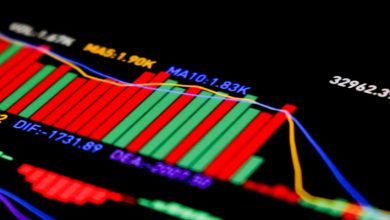The Relationship Between Traditional Markets and Cryptocurrencies

- Understanding the Role of Traditional Markets in Shaping Cryptocurrency Trends
- The Impact of Economic Indicators on Cryptocurrency Prices
- Exploring How Traditional Market Volatility Affects Cryptocurrency Investments
- The Evolution of Cryptocurrency Trading in Relation to Traditional Market Practices
- Analyzing the Correlation Between Stock Market Performance and Cryptocurrency Value
- Challenges and Opportunities in Integrating Traditional Markets with the Cryptocurrency Ecosystem
Understanding the Role of Traditional Markets in Shaping Cryptocurrency Trends
Traditional markets play a significant role in influencing the trends and movements of cryptocurrencies. The relationship between traditional markets and cryptocurrencies is complex and multifaceted. Understanding how traditional markets impact the crypto space is crucial for investors and traders looking to navigate this dynamic landscape.
One key way in which traditional markets shape cryptocurrency trends is through market sentiment. **Investors** and traders often look to traditional markets as a barometer for overall market sentiment. If traditional markets are bullish, this positive sentiment can spill over into the cryptocurrency market, driving up prices. Conversely, if traditional markets are bearish, this can lead to a sell-off in cryptocurrencies as investors seek safer assets.
Moreover, traditional markets can also impact cryptocurrencies through regulatory developments. **Regulatory** changes in traditional markets, such as increased scrutiny or bans on certain financial activities, can have a ripple effect on the cryptocurrency market. For example, regulatory crackdowns on traditional financial institutions may drive investors towards cryptocurrencies as an alternative investment.
Additionally, economic indicators and events in traditional markets can influence the value of cryptocurrencies. **Economic** data such as GDP growth, inflation rates, and interest rates can impact investor confidence and risk appetite, which in turn can affect the demand for cryptocurrencies. Events such as geopolitical tensions or trade wars can also create volatility in traditional markets, leading investors to seek refuge in cryptocurrencies as a hedge against uncertainty.
Overall, the relationship between traditional markets and cryptocurrencies is a complex and ever-evolving one. By understanding the role that traditional markets play in shaping cryptocurrency trends, investors and traders can make more informed decisions and navigate the crypto market more effectively.
The Impact of Economic Indicators on Cryptocurrency Prices
When examining the relationship between traditional markets and cryptocurrencies, it is important to consider the impact of economic indicators on cryptocurrency prices. Economic indicators such as inflation rates, GDP growth, and interest rates can have a significant influence on the value of cryptocurrencies. For example, when inflation rates rise, investors may turn to cryptocurrencies as a hedge against inflation, driving up their prices. Similarly, when GDP growth is strong, investors may have more disposable income to invest in cryptocurrencies, leading to an increase in their prices.
Interest rates also play a crucial role in determining cryptocurrency prices. When interest rates are low, borrowing costs are reduced, making it more attractive for investors to borrow money and invest in cryptocurrencies. On the other hand, when interest rates are high, borrowing costs increase, which may lead to a decrease in cryptocurrency prices as investors are less likely to take on debt to invest.
Overall, economic indicators can provide valuable insights into the relationship between traditional markets and cryptocurrencies. By monitoring these indicators and understanding how they influence cryptocurrency prices, investors can make more informed decisions when trading cryptocurrencies in conjunction with traditional markets.
Exploring How Traditional Market Volatility Affects Cryptocurrency Investments
Exploring how **traditional market volatility** can impact **cryptocurrency investments** is crucial for understanding the **relationship** between these two **financial** realms. When **traditional markets** experience **fluctuations** such as **stock market crashes** or **economic recessions**, it can have a **direct impact** on the **value** of **cryptocurrencies**. **Investors** often turn to **cryptocurrency** as a **hedge** against **traditional market volatility**, viewing it as a **store of value** that is **immune** to **government interference**. However, the **volatility** of **cryptocurrencies** themselves can also **exacerbate** **market instability**, creating a **complex** **interplay** between **traditional markets** and **cryptocurrencies**.
The Evolution of Cryptocurrency Trading in Relation to Traditional Market Practices
Over the years, the landscape of cryptocurrency trading has evolved significantly in relation to traditional market practices. While traditional markets like stocks, bonds, and commodities have been around for centuries, cryptocurrencies are a relatively new asset class that has gained popularity in the last decade.
One key difference between cryptocurrency trading and traditional market practices is the decentralized nature of cryptocurrencies. Unlike traditional markets that are heavily regulated by governments and financial institutions, cryptocurrencies operate on a peer-to-peer network without the need for intermediaries. This means that transactions can be conducted directly between users, without the need for a central authority to oversee the process.
Another important aspect of the evolution of cryptocurrency trading is the rise of digital exchanges. These platforms allow users to buy, sell, and trade cryptocurrencies in real-time, similar to traditional stock exchanges. However, unlike traditional exchanges that have set trading hours, digital exchanges operate 24/7, allowing users to trade cryptocurrencies at any time of the day or night.
Furthermore, the introduction of derivative products in the cryptocurrency market has brought it closer to traditional market practices. Derivatives such as futures and options allow traders to speculate on the price movements of cryptocurrencies without actually owning the underlying asset. This has opened up new opportunities for investors to hedge their risks and potentially profit from market fluctuations.
In conclusion, the evolution of cryptocurrency trading in relation to traditional market practices has brought about significant changes in the way assets are bought, sold, and traded. While there are still differences between the two, the increasing integration of cryptocurrencies into the mainstream financial system is a clear indication of the growing relevance of this new asset class.
Analyzing the Correlation Between Stock Market Performance and Cryptocurrency Value
When analyzing the correlation between stock market performance and cryptocurrency value, it is important to consider the various factors that can influence both markets. While traditional markets such as stocks and bonds have been around for centuries, cryptocurrencies are relatively new and have gained popularity in recent years.
One key factor to consider is the overall economic environment. **Stock markets** are often influenced by macroeconomic indicators such as GDP growth, inflation rates, and interest rates. Similarly, **cryptocurrencies** can be impacted by economic factors such as government regulations, technological advancements, and market sentiment. It is essential to analyze how changes in the economy can affect both traditional markets and cryptocurrencies.
Another important factor to consider is investor behavior. **Stock market** investors may have different risk tolerances and investment goals compared to **cryptocurrency** investors. Understanding how these differences can impact market performance is crucial when examining the correlation between the two asset classes.
Additionally, geopolitical events can play a significant role in shaping market trends. Political instability, trade wars, and global conflicts can have far-reaching effects on both **stock markets** and **cryptocurrencies**. By monitoring geopolitical developments, investors can gain insights into how these events may impact market performance.
In conclusion, analyzing the correlation between **stock market** performance and **cryptocurrency value** requires a comprehensive understanding of the various factors that can influence both markets. By considering economic indicators, investor behavior, and geopolitical events, investors can make more informed decisions when navigating these complex and interconnected financial systems.
Challenges and Opportunities in Integrating Traditional Markets with the Cryptocurrency Ecosystem
Integrating traditional markets with the cryptocurrency ecosystem presents both challenges and opportunities for investors and financial institutions alike. This process involves bridging the gap between the conventional financial system and the emerging digital asset landscape.
- One of the main challenges in integrating traditional markets with cryptocurrencies is regulatory uncertainty. The lack of clear guidelines and regulations governing the use of digital assets can deter institutional investors from entering the market.
- Another obstacle is the volatility of cryptocurrencies, which can make it difficult for traditional investors to assess risk and make informed decisions.
- On the other hand, integrating traditional markets with the cryptocurrency ecosystem can provide opportunities for diversification and access to new investment options.
- Blockchain technology, which underpins cryptocurrencies, offers the potential for increased transparency, security, and efficiency in financial transactions.
- Moreover, by integrating traditional markets with cryptocurrencies, investors can benefit from the liquidity and accessibility of digital assets.






